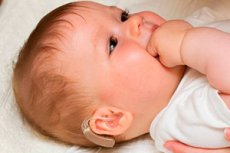New publications
Gene therapy trial: restoring hearing in children with hereditary deafness
Last reviewed: 02.07.2025

All iLive content is medically reviewed or fact checked to ensure as much factual accuracy as possible.
We have strict sourcing guidelines and only link to reputable media sites, academic research institutions and, whenever possible, medically peer reviewed studies. Note that the numbers in parentheses ([1], [2], etc.) are clickable links to these studies.
If you feel that any of our content is inaccurate, out-of-date, or otherwise questionable, please select it and press Ctrl + Enter.

In a recent study published in the journal Nature Medicine, researchers evaluated the safety and efficacy of adeno-associated virus 1 (AAV1)-human otoferlin (hOTOF) binaural therapy in five children with autosomal recessive deafness type 9 (DFNB9).
Millions of people worldwide suffer from hearing loss caused by abnormalities in the OTOF gene, resulting in DFNB9.
Gene therapy is a promising treatment option for inherited deafness, and studies show that single-arm AAV1-hOTOF therapy is safe and associated with functional benefits.
Binaural hearing restoration may provide additional benefits such as improved speech perception and sound localization. However, existing neutralizing antibodies against AAV may prevent infection of target cells and tissues by causing immunotoxicity and limiting repeat delivery.
The present study aimed to evaluate the safety and efficacy of binaural AAV1-hOTOF gene therapy in patients with DFNB9.
The researchers assessed 316 volunteers for participation in the study, of which five children (three boys and two girls) with congenital hearing loss in both ears due to biallelic mutations of the OTOF gene were included in the study between July 14 and November 15, 2023.
Participants had OTOF gene mutations and brainstem sound response (ABR) levels ≥65 dB in both ears. Exclusion criteria included AAV1 neutralizing antibody ratio>1:2,000, preexisting otologic diseases, history of substance abuse, complex immunodeficiency or organ transplant, history of neurological or psychiatric disorders, and history of radiotherapy and chemotherapy.
In a single operation, the researchers injected 1.50 x 10^12 AAV1-hOTOF vector genomes (vg) into the patients' bilateral cochleas through the round window of the ear.
Participants did not experience dose-limiting toxicities or serious adverse events. There were 36 grade 1 or 2 adverse events, the most common of which were elevated lymphocytes (six of 36) and cholesterol (six of 36).
All patients achieved bilateral hearing restoration. At baseline, the average ABR threshold for the right (left) ear was greater than 95 dB.
After 26 weeks, the threshold recovered to 58 dB (58 dB) in the first patient, 75 dB (85 dB) in the second patient, 55 dB (50 dB) in the third patient, 75 dB (78 dB) in the fourth patient, and 63 dB (63 dB) in the fifth patient.
At 13 weeks post-treatment, mean ABR thresholds were 69 dB for the five patients receiving binaural treatment and exceeded 64 dB for the five patients receiving unilateral treatment. Mean ASSR thresholds were 60 dB for the binaural gene therapy patients and 67 dB for the unilateral patients.
All five patients regained speech perception and the ability to localize sound sources. The team found that MAIS, IT-MAIS, CAP, or MUSS scores improved in all patients.
Six weeks after treatment, all patients developed neutralizing antibodies to AAV1. Neutralizing antibody titers in binaural gene therapy recipients were 1:1,215, while titers in unilateral dose recipients ranged from 1:135 to 1:3,645.
One week after treatment, no patient's blood tested positive for vector DNA. Six weeks after binaural AAV1-hOTOF gene therapy, IFN-γ ELISpot responses to AAV1 capsid peptide pools were negative.
Based on the study results, binaural AAV1-hOTOF gene therapy is safe and effective for patients with DFNB9. The study results expand treatment options and stimulate further development of gene therapy for inherited deafness caused by various genes.
